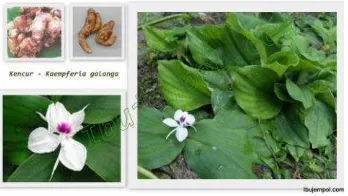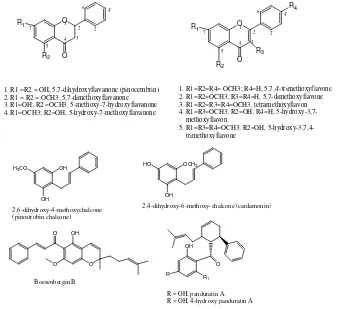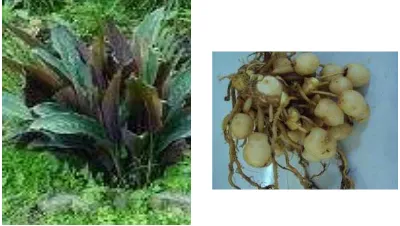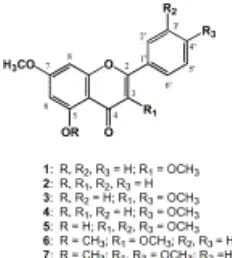P-1
PHYTOCHEMICAL OF
KAEMPFERIA
PLANT AND BIOPROSPECTING FOR
CANCER TREATMENT
Sri Atun
Chemistry education Faculty of Mathematical and Natural Science, Yogyakarta State University,
Jl. Colombo No. 1 Yogyakarta, Indonesia, 55281 e-mail : Atun_1210@yahoo.com
Kaempferia genus is perennial member of the Zingiberaceae family and is cultivated in Indonesia and other parts of Southeast Asia. Number of studies has been conducted, providing information related to Kaempferia as antioxidant; antimutagenic; and chemopreventive agent. This paper reports some isolated compounds from this plant, biological activity, and bioprospecting for cancer treatment.
Keyword: Cancer treatment; Kaempferia; Zingiberaceae INTRODUCTION
Kaempferia is a genus, belong to family of Zingiberaceae. This plant grows in Southeast Asia, India, Sri Lanka, Indonesia, and Southem China. Kaempferia genus sinonim with
Boesenbergia genus by Baker. This plant has 8 different botanical names which are
Boesenbergia cochinchinensis (Gagnep.) Loes., Boesenbergia pandurata (Roxb.) Schltr.,
Curcuma rotunda L., Gastrochilus panduratus (Roxb.) Ridl., Gastrochilus rotundus (L.) Alston,
Kaempferia cochinchinensis Gagnep., Kaempferia ovate Roscoe, Kaempferia galanga,
Kaempferia rotunda, and Kaempferia pandurata Roxb nonetheless it is currently known as
Boesenbergia rotunda (L.)Mansf (Tan Eng-Chong, et. al, 2012). The plants grown naturally in damp, shaded parts of the lowland or on hill slopes, as scattered plants or thickets. Economically important species among the plant families, the Zingiberaceae, which are perennial rhizomatous herbs, contain volatile oil and other important compounds of enormous medicinal values (Singh C.B., 2013).
Phytochemical and biologycal activities of some species of Kaempferia
Phytochemical and biologycal some species of plants of the genus Kaempferia reported by many researchers, among others:
1. Kaempferia galanga (Kencur)
The Kaempferia galanga is a native of India, China, Taiwan, Cambodia, and other areas of southeast Asia. K. galanga or kencur in the local name in Indonesi is a flowering perennial plant that prefers a warm growing environment reminiscent of its tropical countries. K. galanga
also prefers shady growing conditions and moist soil. The plant has small flowers that grow in clusters at the center of its three large, broad, dark green leaves. Flowers are most often white, pink, or lavender in color (Fig. 1). Since the rhizomes of this plant contain volatile oil and other important compounds of enormous medicinal values, they are very demanding to the traditional health care practitioner.The rhizome of this plant has been used traditionally for the treatment of many ailment and few biological activities have proven its importance. The rhizome is rich in essential oils and is being used for the treatment of indigestion, cold, pectorial and abdominal
pains, headache, expectorant, diuretic, carminative, stomachic, coughs, pectoral affections, asthma and hypertension. The rhizoma used as an entheogeon and aphrodisiac in New Guinea, a flavor rice, and the root and leaves are put into curries as a flavoring South Asia like Indonesia, Malaysia, and Thailand. The rhizoma and edible fresh leaves represent a potential food values (Sing C.B., 2013).
Figure.1. Rhizome and plant of K. galanga
Number of publications on the phytochemistry has to do with the essential oil and extracts from the rhizome and leaf of this plant. Some compounds can be identified from oil extract from rhizome of K. galanga include 3-carene, camphene, borneol, cineol, kaempferol, kaempferide, cinnamaldehyde, metho-xycinnamic acid, ethyl cinnamate and ethyl p-methoxycinnamate. 3-Caren-5-one, carvon, eucalyptol, and pentadecane, and flavonoids from the leaves (Shing C.B., 2013). Some compounds was identified from K. galanga can be seen in figure 2.
Figure 2. Some compounds was identified from K. galanga
Many researches reported biologycal activities of K. galanga. The rhizomes are stimulatory, expectorant, carminative, and diuretic. The methanol extract of the rhizome contains ethyl p-methoxy-trans-cinnamate, which is highly cytotoxic to Hela cells. Crude extracts of the rhizome of K. galanga with petroleum ether, acetone and methanol are screened
P-3
for antimicrobial activities against two gram-positive and three gram-negative
pathogenic bacteria i.e. Bacillus sp., Pseudomonas sp., Escherichia coli, Salmonella sp. and
Shigella sonnei (Singh C.B., 2013).
The aqueous extracts of K. galanga leaves show significant antinociceptive and anti-inflammatory effect in rats. The rhizome essential oils extracted from the rhizomes of K. galanga have shown considerable repellent and larvicidal activity against a number of mosquito species including Aedes aegypti . K. galanga extracts have weak anti-oxidant activity. Total phenolic content of ethanolic extracts of leaves and rhizomes is found to be 146 mg galic acid equivalent (GAE)/100 g and 57 mg GAE/100 g, respectively whereas the antioxidant activity of leaves and rhizome extracts is 77 mg ascorbic acid (AA)/100 g and 17 mg AA/100 g. This anti-oxidant activity is further reduced by drying using different thermal and non-thermal drying methods, however, this decrease is prevented if the plant is subjected to freez-drying. This antioxidant activity is mainly due to the total phenolic content and flavonoids, including luteolin and apigenin (Chan et al., 2009).
2. Kaempferia pandurata ( Boesenbergia pandurata)
Boesenbergia pandurata (ROXB.) SCHLTR. [syn. B. Rotunda (L.) MANSF.
KULTURPFL., sinonim with Kaempferia pandurata ROXB.], belonging to the family
Zingiberaceae, is a perennial herb distributed in some tropical countries including Indonesia,
Malaysia, Myanmar, and Thailand. The local name in Indonesia is ―Temu kunci‖, this plant is a common edible ingredient in many Asian countries. It is normally cultivated at small home ranches and used as a condiment in food such as curry and soup due to its aromatic flavour, which promotes appetite. This herbal plant is also used as a traditional medicine to treat illnesses such as rheumatism, muscle pain, febrifuge, gout, gastrointestinal disorders, flatulence, carminative, stomach ache, dyspepsia, and peptic ulcer. In Indonesia, B. rotunda is typically
used to prepare ―jamu,‖ a popular traditional tonic for women after childbirth as well as a beauty aid for teenage girls and to prevent leukorrhea (Tan Eng Chong, 2012). The rhizoma and the plant of K. pandurata in figure 3. The fresh rhizomes have a characteristic aroma and are used as a flavoring agent in Thai cuisine, it has been commonly used as self-medication by AIDS patients in southern Thailand. Previous investigations of the chemical constituents of B. pandurata reported the anti-HIV, antibacterial, anti-inflammatory, analgesic, antipyretic, antitumor, antioxidant, and insecticidal activities (Tan Eng Chong, 2012).
Figure 3. Plant and rhizoma of K. pandurata (Tan Eng Chong, 2012)
5,7,3,4-tetramethoxy-flavone, 5-Hydroxy-3,7-dimethoxyflavone, 5-Hydroxy-3,7,4-tri-methoxyflavone, 3,5,7-trimethoxy-flavone 5-hydroxy-3,7,3,4-tetramethoxy-flavone, 5,7-dihydroxyflavanone (pinocembrin), 2,6-di-hydroxy-4-methoxychalcone (pinostrobin chalcone), 2,4-dihydroxy-6-methoxy-chalcone (carda-monin), boesenbergin B, panduratin A, 4-hydroxy panduratin A (Tan Eng Chong, 2012). Some structure of the isolated compounds from K.
pandurata can be seen at Figure.4.
Figure 4. Structure isolated compounds from K. pandurata
Some essential oil from K. pandurata rhizoma identified such as geranyl formate, geranyl propionate, geraniol, neral, myrcene, isoborneol, pinene, neryl acetate, geranial, -thujaplicin (E,E)-α-farnesene, borneol, tricyclene, terpinen-4-ol, terpinolene, myristicin, allo ocimene, α-thujene, (Z)- -ocimene, sabinene, (E)- -ocimene, (Z)-nerolidol, cis-linalool oxide, 3-carene, δ-elemene, (Z)- -farnesene, -elemene, -elemen (Jantan et al. (2001) cited by Tan Eng Chong, 2012). The polyphenols compounds can be identified such as quercetin, kaempferol, naringin, hesperidin, caffeic acid, p-coumaric acid, chlorogenic acid (Jing et al. (2009) cited by Tan Eng Chong, 2012). Many researcher reported of the chemical constituens of
B. pandurata have activity as anti-HIV, antibacterial, anti-inflamasi, analgesic, antipyretic, antitumor, antioxidant. Some compounds such as panduratin isolated from B. pandurata showed cytotoxic against pancreatic PANC-1 cancer cell under nutrient deprived condition (Nwet Nwet Win, 2008).
4. Kaempferia rotunda
Kaempferia rotunda (Zingiberaceae), known as kunci pepet or kunir putih in Indonesia, has been traditionally used in as abdominal pain, sputum laxative, wounds and diarrhea colic
P-5
disorder. The plant is used in the folk medicinal system of Bangladesh for treatment of high blood sugar levels as commonly observed in diabetic patients, as well as for treatment of pain. The plant is considered to be an important medicinal plant also in the ancient traditional medicinal system of India, namely, Ayurveda. The Ayurvedic drug, hallakam, containing tubers of the plant is considered as stomachic, antiinflammatory to wounds and bruises, and useful for treatment of mental disorders and insomnia (Sereena et al., 2011). The plant and rhizoma of K. rotunda can be seen in figure 5.
Figure 5. The plant and rhizoma of K. rotunda
Stevenson et. al (2007) reported nine new isolated compounds from methanol extracts of rhizomes of K. rotunda , that reportedly contained six polyoxygenated cyclohexane derivatives identified as (-)-6-acetylzeylenol (1), zeylenol (2), four acylated derivatives of 1-benzoyloxymethyl-1,6- epoxycyclohexan-2,3,4,5-tetrol (6), a Diels-Alder adduct of
3-benzoyl-1-benzoyloxy-methylcyclohexa-4,6dien-2,3-diol (7), crotepoxide (8), and
2-(benzoyloxymethylphenyl-(3,6-di-O-acetyl)-b-glucopyranoside (9). Some compounds
demonstrated antifeedant activities against larvae of Spodoptera littoralis, the Egyptian cotton leafworm (Stevenson et al., 2007). Lotulung et.al (2008) reported two compounds has been identified from rhizomes of the plant, namely, 2'-hydroxy'-4,4',6'-trimethoxy-chalcone and (+) crotepoxide, the first possessing antioxidant activity. Three known flavanone can be isolated from chloroform extract from K. rotunda, namely 5-methoxy-7-hydroxy-flavanone, 5-hydroxy-7-metoksi-flavanon, and 5,7-dihydroxyflavanone (Sri Atun, 2013). Structure of the isolated compounds from K. rotunda can be seen at figure 6.
The antioxidant potential of the plant has been evaluated and flavonoids and phenolic derivatives found in the plant, which demonstrated inhibitory potential against lipid peroxidation, suggesting that the plant can be useful in diseases like myocardial infraction, diabetes mellitus, hepatic injury, atherosclerosis, rheumatoid arthritis, and cancer (Lotulung, 2008; Prassad, 2010). Cytotoxic test against the two compounds 5-hydroxy-7-metoksiflavanon and 5,7-dihydroxy-flavanones against MCF-7 cancer cells; HCT 116; Ca ski, and A549 showed that the compound 5,7-dihydroxyflavanone have cytotoxic activity more high. The fact showed hydroxyl group at position C-7 of this structure can increase the cytotoxic activity. Pinostrombin
RO
Figure 6. Isolated compounds from K. rotunda
Some flavanone compounds from K. rotunda also have activity as antimutagenic. Although the biochemical mechanisms underlying flavanone compounds activities are not yet clear, these results demonstrated that K. rotunda has a preventive effect against chromosome fragmentation in vivo, probably due to its free radical scavenging capability. Moreover, study showed that phenolic compounds have bioactivity as antioxidant, antimutagenic, and chemopreventive. Therefore, these results confirm and extend our knowledge on the ability of methanol extract and isolated flavanone compounds from K. rotunda to protect DNA, showing that both prevent chromosome damage after cyclophosphamid exposure in mice (Sri Atun, 2013). Prasad et. al (2010) investigated the effect of crotepoxide on TNF- and chemotherapy-induced apoptosis and on NF-κB signaling pathway activation. crotepoxide alone showed suppressed the proliferation of various types of tumor cells and potentiated TNF- and chemotherapeutic drugs-induced apoptosis. This correlated with the down-regulation of various gene products that mediate inflammation, cell proliferation, cell survival, invasion, and angiogenesis, all of which are regulated by NF-κB.
4. Kaempferia parviflora
Kaempferia parviflora (Thai Ginseng) is a herb that has some historical and medicinal usage for treating metabolic ailments and improving vitality in Thailand and limited to surrounding regions. It is also reported to be an aphrodisiac compound and physical enhancer. Leaves are green with a reddish underside. It has been used as a medicinal plant in Asia (Leardkamolkarn V, 2009). The plant K. parviflora and this rhizome at figure 7.
P-7
Figure 7. The plant and rhizoma of K. parviflora (Black ginger)
Some isolated compound from K. parviflora reported by many researchers. They found polyphenolic flavonoids which have a wide range of biological activities, such as inflammatory, bacterial, mutagenic, oxidant, and thrombotic The anti-inflammatory effect has been emphasized for a purified compound, 5,7-dimethoxylflavone. These compounds showed anti-bacterial and anti-fungal activities have been pointed (Tewtrakul S, 2009). Some isolated compounds from K. parviflora can be seen at figure 8.
Figure 8. Some isolated compounds from K. parviflora
Hossain A. et al (2012) reported several studies covered anti-proliferative and cytotoxic effects of the rhizome extracts of Kaempferia parviflora. The present study was evaluated the
cytotoxicity of 3,5,7,4′-tetramethoxyflavone , 5,7,4′-trimethoxyflavone , and 5-hydroxy-3,7,3′,4′-tetramethoxyflavone on human colorectal carcinoma (HCT-15) cells. All three compounds showed a dose-dependent inhibitory effect on HCT-15 cells. Significant numbers of apoptotic nuclei and condensed chromatin were also observed. These results strongly suggest that three compounds caused cell death via an apoptotic pathway. Therefore all these compounds have the potentiality to be the novel anti-cancer drugs.
CONCLUSION AND SUGGESTION
The current state of research of some species on Kaempferia genus clearly shows that the isolated bioactive compounds have high potential in treating many diseases. Chemical constiuents that have been reported for the some species of Kaempferia include cyclohexane oxide derivatives, chalcone derivatives, cinnamates, diterpenes, monoterpenes, and flavonoids. Some bioactive compounds showed high cytotoxic effects againt some cancer cell lines, so these plant have the bioprospecting for cancer treatment.
The genus Kaempferia is one of the Zingiberaceae family of plants that is widely available in Indonesia and contain a variety of bioactive compounds that are useful, it needs to be preserved and developed to produce quality drugs.
Refference
Chan, E.W.C.; Lim, Y.Y.; Wong, S.K.; Lim, K.K.; Tan, S.P.; Lianto, F.S. and Yong, M.Y. 2009, Effects of drying methods on the antioxidant properties of leaves and tea of ginger species. Food Chemistry, vol. 113, no. 1, p. 166-172
Hossain Md. A, Wongsrikaew N, Yoo G.W., Han J., Shin C.G, 2012, Cytotoxic effects of polymethoxyflavones isolated from Kaempferia parviflora , Journal of the Korean Society for Applied Biological Chemistry , Vol. 55, Issue 4, 471-476
Leardkamolkarn V, Sunida Tiamyuyen, Bung-orn Sripanidkul , 2009, Pharmacological Activity of Kaempferia parviflora Extract against Human Bile Duct Cancer Cell Lines, Asian Pacific Journal of Cancer Prevention, Vol 10.
Lotulung Puspa DN, Minarti, Kardono LBS, Kawanishi K, 2008, Antioxidant compounds from rhizomes of Kaempferia rotunda l, Pakistan J. Of. Biol. Sci, 11 (20), 2447-2450
Nwet Nwet W.,Suresh A.,Hiroyasu E.,Yasuhiro T.,and Shigetoshi K. , 2008,Panduratins D— I, Novel Secondary Metabolites from Rhizomes of Boesenbergia pandurata, Chem. Pharm. Bull. 56(4) 491—496
Prasad S., Vivek R. Yadav, Chitra Sundaram, Simone Reuter, Padmanabhan S. Hema, Mangalam S. Nair, Madan M. Chaturvedi, and Bharat B. Aggarwal, 2010, Crotepoxide Chemosensitizes Tumor Cells through Inhibition of Expression of Proliferation, Invasion, and Angiogenic Proteins Linked to Proinflammatory Pathway, J Biol Chem, 285(35): 26987–26997.
Singh C,B, Binita Chanu S, Bidya baby Th , Radhapiyari Devi W, Brojendro Singh S, Nongalleima, Lokendrajit. N, Kh, Swapana. N, and Singh L.W, 2013, Biological and Chemical properties of Kaempferia galanga L. Zingiberaceae plant , NeBio, Vol.4, No. 4, 35-41.
Sereena, K., Prakash Kumar, U., and Rema Shree, A.B., 2011. Histochemical and phytochemical markers for the authentication of Ayurvedic raw drug Hallakam (Kaempferia rotunda) and its marketed adulterant. International Journal of Pharmaceutical Sciences and Research, 2: 2952-2958.
Sri Atun, Retno A, Eddy S, Nurfina Az, 2013, Isolation and antimutagenic activity of some flavanone compounds from Kaempferia rotunda, Int. J. of. Chem.and Anal. Sci. 4 , 3-8 Stevenson P.C, Nigel C.V., Monique S.J.S, 2007, Polyoxygenated cyclohexane derivatives and
other constituents from Kaempferia rotunda L., Phytochemistry, 68, 1579-1586
Tan Eng-Chong, Lee Yean-Kee, Chee Chin-Fei, Heh Choon-Han, Wong Sher-Ming, Christina Thio Li-Ping, Foo Gen-Teck, Norzulaani Khalid, Noorsaadah Abd Rahman, Saiful Anuar Karsani, Shatrah Othman, Rozana Othman, and Rohana Yusof, 2012, Boesenbergia
rotunda : FromEthnomedicine to Drug Discovery, Evidence-Based Complementary and
Alternative Medicine , Article ID 473637, 25 pages




